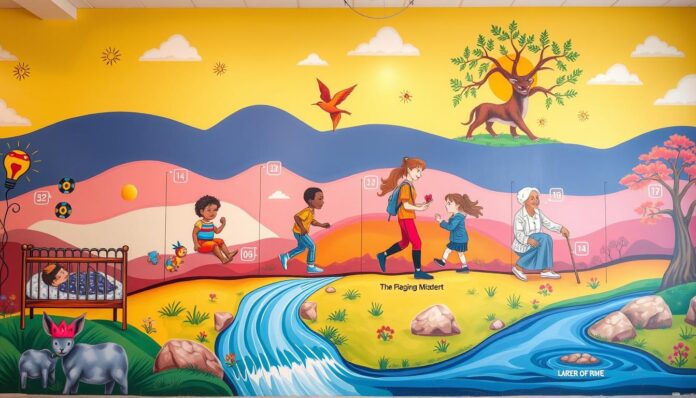A vibrant and colourful mural depicting various age milestones and life stages, featuring a timeline of life events represented by symbolic imagery: a baby in a crib, a child playing with toys, a teenager exploring a world of education and friendships, a young adult embarking on a career journey, and an elder enjoying moments of wisdom and reflection, all interconnected through a flowing river of time in a serene landscape.
Edad shows how people grow from birth to old age. It’s a journey of change and growth.
Edad is more than just a number. It includes how we change in body, mind, and social life.
Each age brings new things to learn and do. We face different tasks at every stage of life.
Age shows how we grow, from baby to senior. Experts study these changes to better understand human growth.
Life stages are not just about time passing. They show how we change in many ways.
Edad helps us see how complex growing up is. We keep learning throughout our whole life.
What is Edad and Why It Matters
Edad means “age” in Spanish. It’s more than just a number. It shows how people grow and live.
Age helps us see essential steps in growing up. Different cultures view education in unique ways. In the U.S., age often decides legal rights and school chances.
Some cultures view ageing as wise, while others prefer being young. These views shape how people live and talk to others.
Age affects many parts of life. Doctors use it to check health, and sociologists study how it changes society.
Edad is more than numbers. It shows how we grow and what we can do.
Key Age Milestones in Infancy
Babies grow fast in their first year. They change quickly, showing fantastic progress.
Infants start with basic skills. At 2-3 months, babies smile for real.
By 4-6 months, they can roll over. This shows better muscle control.
Sitting up alone is a big step. Most babies do this at 6-7 months.
Crawling comes next, usually between 7-10 months. Babies explore and improve coordination.
The first steps happen around 9-15 months. This shows growing independence.
Each baby grows differently. Minor timing differences are typical.
Tracking growth helps parents understand their baby’s progress. Regular check-ups with doctors help monitor development.
Early Childhood Developmental Stages
Toddlers grow and learn fast. They change a lot in their body and mind during preschool years.
Kids start talking more. They go from simple words to short sentences.
Moving skills get better, too. Toddlers learn to run, jump, and handle things well.
Preschoolers learn about feelings. They start to understand others and play together.
Kids become very curious. They ask many questions and use their imagination.
Parents help a lot. They give kids fun things to do and learn from.
The Impact of Edad in Adolescence
Adolescence is a time of significant changes for teens. It shapes who they are and what they can do.
Puberty is the most significant change during this time. Teens grow fast, and their bodies change a lot.
These changes can make teens feel strong emotions. They start to think more about who they are.
Teens start to form their ideas and values. They also make new friends and think in new ways.
Friends become very important to teens. They can affect how teens act and feel about themselves.
Teens face new social challenges. They try to figure out who they are and what others expect.
Understanding these changes helps adults support teens better. Each teen grows in their way.
Teens learn essential skills for life. They get ready for grown-up tasks and build inner strength.
Understanding Adult Edad
Adult education is a journey of growth and change. It involves many life transitions that shape our experiences.
These periods require essential decisions about careers, relationships, and personal identity. Career growth is a key part of adult education.
Professionals move from entry-level jobs to leadership roles. The workplace tests skills, flexibility, and emotional intelligence.
Relationships change a lot during adulthood. People seek long-term partners and think about marriage.
Family planning becomes important, too. These changes need emotional maturity and good communication.
Personal growth is central to adult education. People keep learning and exploring new interests.
They also refine their goals. Self-reflection helps people reassess their values and dreams.
Adult education links personal, work, and emotional growth. Each change offers chances to grow and adapt.

Navigating the Middle Ages and Beyond
A serene landscape depicting various milestones of midlife features pathways leading to symbolic representations of balance, growth, and reflection. Elements include a tranquil forest with a bridge, a serene lake reflecting the sky, and abstract sculptures representing personal achievements. Soft, warm colours evoke a sense of calm and introspection.
Midlife edad is a journey of growth and self-discovery. It brings new challenges and chances to reshape our lives.
Career changes become more common during this time. Many people explore new paths or reinvent their current jobs.
Empty nest syndrome is a significant emotional change. Parents feel shifts as kids grow up and leave home.
This time calls for mental strength and flexibility. People think deeply about who they are and what they want.
Retirement planning becomes essential in midlife. People must prepare for financial stability and health in later years.
Health takes centre stage during this time. More focus goes to preventive care and good eating habits.
Staying active is key to feeling young. Regular exercise and learning new things help keep minds sharp.
Making friends and staying social is vital, too. Many find new purpose through helping others or exploring hobbies.
Embracing change is crucial for ageing well. Viewing midlife as a chance to grow can lead to exciting experiences.
The Science Behind Aging
Ageing involves a mix of genes, environment, and lifestyle factors. Scientists study how cells change as we get older.
Researchers explore cellular damage and molecular changes in ageing. They work at top universities like Stanford and Harvard.
Our lifespan depends on more than just our genes. Diet, exercise, and stress management affect how we age.
New studies show that lifestyle choices can change how our genes work. This can slow down or speed up ageing.
To understand ageing, we examine telomeres and mitochondria. Scientists track molecular changes in ageing humans.
This research helps us find ways to improve health as we age. It could help us live longer, healthier lives.
New ageing research aims to keep cells healthy and strong. New medical technology might help slow age-related decline.
By studying ageing, we hope to find ways to stay healthy longer, which could improve the quality of life for people of all ages.
FAQ
What does “edad” mean?
“Edad” is Spanish for “age.” It refers to how long a person has lived.
In English, we use it to talk about life stages.
At what age do babies typically reach significant developmental milestones?
Babies reach milestones at different times. First smiles appear around 6-8 weeks.
Rolling over happens at 4-6 months. Sitting up starts around 6-8 months.
Crawling begins between 6-10 months. The first steps occur around 12-18 months.
How vital are age milestones in child development?
Age milestones show a child’s growth. They help track physical, mental, and social progress.
These markers help spot delays and ensure proper development.
What are the most significant changes during adolescence?
Adolescence brings significant changes. These include puberty, rapid growth, and identity formation.
Teens gain independence and develop complex social relationships.
How do life stages impact personal development?
Each life stage offers growth chances. Childhood is for learning and skill-building.
Adults focus on careers. Seniors reflect on life experiences.
What factors influence human ageing?
Many things affect aging. These include genes, lifestyle, diet, and exercise.
Stress management, social ties, and healthcare also play a role.
When do people typically experience midlife transitions?
Midlife transitions often happen between 40-60 years old. People reassess careers and family life.
They may change jobs and focus more on personal growth.
How do cultural perspectives on age differ around the world?
Views on age vary worldwide. Some cultures respect elders as wise.
Others value youth more. These beliefs shape how people live.
You can also read more : Funny Kahoot Names: A Guide to Adding Humor to Your Learning Sessions



